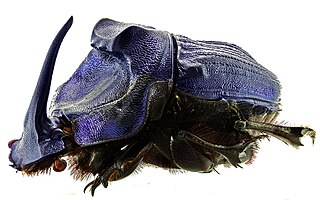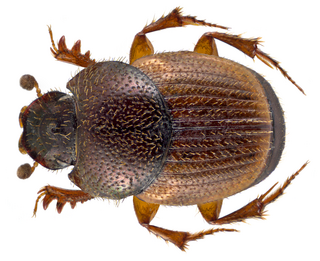
Phanaeus vindex, the rainbow scarab, is a North American species of true dung beetle in the family Scarabaeidae. It is found in eastern and central United States and in adjacent far northern Mexico. It is the most widespread species of Phanaeus in the United States and it has a wide habitat tolerance. It may hybridize with the generally less common P. difformis.

Coprophanaeus is a genus in the family Scarabaeidae. The genus is almost entirely Neotropical, with a single species, C. pluto, ranging into southernmost Texas in the United States. They are medium-sized to large beetles, with the South American C. ensifer and C. lancifer sometimes exceeding 5 cm (2 in) in length, making these two some of the largest dung beetles in the world and the largest in the Americas. They often have a horn on the head, and are typically a bright metallic color, most often blue or green, or black. These diurnal or crepuscular beetles are excellent diggers and good fliers.

Sulcophanaeus is a genus of dung beetles belonging to the family Scarabaeidae. Most species in this genus are from tropical and subtropical South America, but a few are found in Central America and Mexico, and S. carnifex is from Jamaica. Sulcophanaeus are mostly coprophagous, but some are also necrophagous. They are paracoprids, meaning that adults dig tunnels into the soil under the food source and move parts of the food source to a nest chamber where the eggs are laid, and their activity pattern varies depending on species.

Oxysternon festivum is a species of dung-beetle of the scarab beetle family.

Bodiloides ictericus is a species of dung beetle in the family Scarabaeidae, found in the Palearctic. It is one of more than 50 species in the genus Bodiloides.

Oxysternon conspicillatum is a species of dung beetle in the family Scarabaeidae. It is widespread and common in both evergreen and semi-deciduous mesic forests, including disturbed habitats, ranging from near sea level to an altitude of 3,000 m (9,800 ft) in the Amazon basin and Chocó of tropical South America and Panama, possibly extending as far west as the border region with Costa Rica. Both adults and young of this common and widespread beetle primarily feed on dung, but the species has also been recorded feeding on dead animals.

Caccobius unicornis, is a species of dung beetle found in many Asian and South East Asian countries such as: India, Sri Lanka, China, Java, Borneo, Taiwan, Korea, Japan, Myanmar, North Vietnam, Philippines, Sumatra, Java, Borneo, Malaysia, Thailand, and Indochina.
Catharsius capucinus, is a species of dung beetle found in India, Sri Lanka, Bangladesh and Nepal.
Cleptocaccobius inermis, is a species of dung beetle found in India and Sri Lanka.
Garreta smaragdifer is a species of dung beetle native to India and Sri Lanka.

Heliocopris bucephalus, commonly known as Elephant dung beetle, is a species of dung beetle found in India, Sri Lanka, Bangladesh, Myanmar, Malay Peninsula, Java, Vietnam, Laos, and Cambodia.
Scarabaeus erichsoni, is a species of dung beetle found in India, and Sri Lanka. Sometimes, the species is classified as Kheper erichsoni.

Onthophagus centricornis is a species of dung beetle found in India, Sri Lanka and Afghanistan. It is a small arboreal dung beetle inhabited in both dry and wet forests.

Onthophagus centricornis, is a species of dung beetle found in Pakistan, Saudi Arabia, Sri Lanka, Vietnam, India, Andaman and Nicobar Islands and Thailand.

Onthophagus dama, is a species of dung beetle found in Nepal, Bhutan, India, and Sri Lanka.
Onthophagus falsus, is a species of dung beetle found in India, Sri Lanka and Pakistan.
Onthophagus heterorrhinus, is a species of dung beetle found in India, Sri Lanka and Myanmar.
Onthophagus ludio, is a species of dung beetle found in India, and Sri Lanka.
Onthophagus spinifex, is a species of dung beetle found in India, Sri Lanka, Bangladesh and China.
Phalops divisus, is a species of dung beetle found in India, Sri Lanka, and Pakistan.













